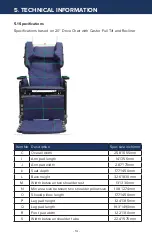
- 5 -
2. SAFETY REQUIREMENTS
2.5.3 Location of Chair - “Danger of Tipping or Falling Objects”
W
e recommend when a resident has been moved to their destination, the
chair is placed where the resident cannot reach handrails or other objects,
fixed or movable. This is to prevent the resident from pulling the chair over
or pulling themselves off the seating surface and to prevent the resident
from pulling movable objects onto the chair and themselves.
W
e recommend the chair be used in a supervised area to prevent untrained
residents, caregivers, or third parties from unauthorized operation,
movement, or unsafe actions such as sitting or leaning on the reclined
back, elevated footrest, or the armrests. These actions, if not prevented,
put the chair at risk of tipping or damage to the chair.
W
e recommend a chair only be located on a level surface to minimize the
risk of tipping over.
2.5.4 Total Lock Wheel Brakes - “Danger of Falling”
T
he special casters found on the DRIVE chair have total lock brakes which
prevent the wheels from turning and swiveling. The brakes must always be
applied when:
1
. The chair is not in use
2. A resident is being transferred (moved) into or out of the chair; and
3. The chair is not being moved by a caregiver.
It is important to note if the wheel locks are applied while the patient is in
the chair, the caregiver does not leave the patient unattended, especially
those patients who have the capability or tendency to move the chair and/
or those who may be agitated. This could cause harm to the patient if they
attempt to move the chair while the wheel locks are applied.
Note that removing and attaching the footrest may be easier for the
caregiver with the brakes applied. Failure to follow these instructions will
unnecessarially increase the risk of serious falls by residents, caregivers, or
third parties caused by the chair unintentionally moving.






































